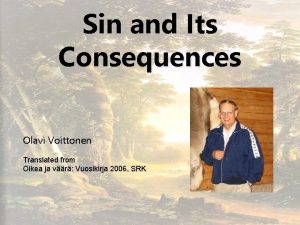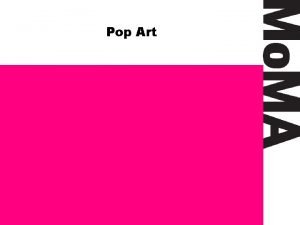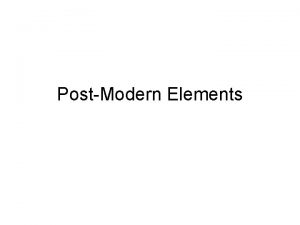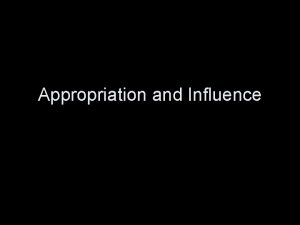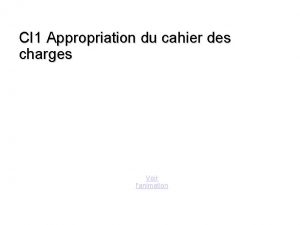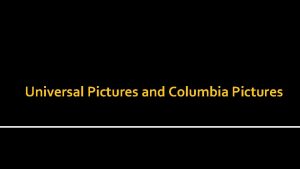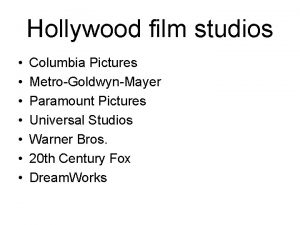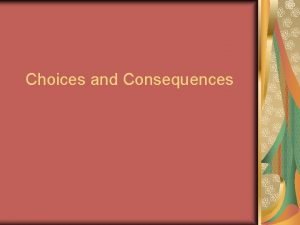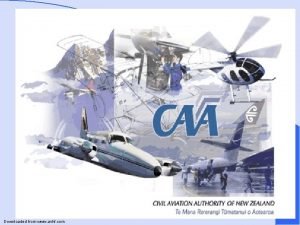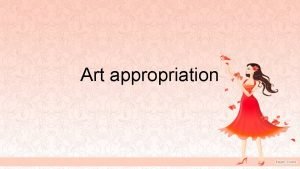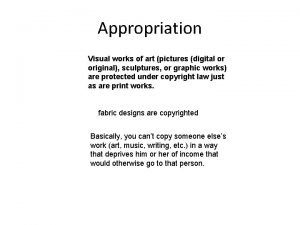Taking Pictures Appropriation and its Consequences Threepart test

















- Slides: 17

Taking Pictures: Appropriation and its Consequences Three-part test question: Jack Goldstein, Metro-Goldwyn-Mayer, 1975. 16 mmm film, Color, sound a) Explain appropriation theory. b) Include the dates when it became a major strategy for contemporary artists, and explain why it did from a a historical perspective. c) Be able to fully identify artworks in this lecture and explain how they deploy appropriation. Use lecture notes and chapter two of your textbook to prepare for the exam.

The 1977 Pictures exhibition at the alternative New York gallery Artists Space, and the catalog essay by Douglas Crimp, marks the launch of appropriation art, 1977 through the 1980 s Crimps essay is available on our course “Readings” webpage: file: ///C: /Users/Elaine%20 O'Brien/Documents/my%20 csus%20 website/art 112/Readings/Douglas%20 Crimp%20 Pictures%201977. pdf

Sherrie Levine, Untitled (President 4), 1979. Collage on paper, 24 x 18" (60. 9 x 45. 7 cm). The Metropolitan Museum of Art, New York

(left) Sherrie Levine, After Walker Evans: 7, 1981, gelatin silver print, 5 1∕ 16 x 3 7∕ 8, " (right) Walker Evans, Farmhouse Hale County, Alabama, 1936, gelatin silver print. 71 1∕ 16 x 6 5∕ 16“ it the other way around? ) Key text: Rosalind Krauss: “The Originality of the Avant-garde and other Modernist Myths” (or is

“Modernism and the avant-garde are functions of what we could call the discourse of originality, and that discourse serves much wider interests. ” Rosalind Krauss: “The Originality of the Avant-garde and other Modernist Myths” See Kalb, page 53. “Krauss concluded her essay with a reference to Sherrie Levine, suggesting that appropriation, by disavowing the contest between original and copy, provided a way out of the binary conflicts of Modernism (such as real vs. fake, high art vs. low art) and heralded a Postmodernism. ” Note: For the next test, be able to explain appropriation theory and how an artwork from this lecture is informed by it.

(left) Sherrie Levine (US Postmodern Appropriation artist, b. 1947) Untitled (After Alexander Rodchenko: 9), 1987 (right) Alexander Rodchenko (Russian Constructivist, avant-garde modernist), 1891 -1956), Portrait of Mother, 1924 Postmodern “Appropriation” of “high” art challenged modernism’s key values of “originality” and “aura. ” Key text: Walter Benjamin, “The Work of Art in the Age of Mechanical Reproduction” http: //www. marxists. org/reference/subject/philosophy/works/ge/benjamin. htm

Cindy Sherman (US, b. 1954) Untitled Film Still #27, 1979 69 film stills from 1977 (artist started when she was 23 years old) to 1980. She stopped making film stills, she explained, when she ran out of clichés.

Cindy Sherman, (left) Untitled Film Still #35, 1979; (right) Untitled Film Still #54. 1980 The Museum of Modern Art, New York. 8 x 10” glossies just like “real” film stills. "She's good enough to be a real actress. “ Andy Warhol

Study question: What is Laura Mulvey’s theory of the gaze in “Visual Pleasure and the Narrative Cinema” 1975? See Kalb pp. 54 -55) and be able to apply Mulvey’s ideas to an artwork in this lecture for the next test. The “Scopophilic Gaze” – sensations of touch satisfied by seeing. Voyeurism. “The Narcissistic Gaze” – identification with the hero of the film In both kinds of looking, Freud and filmmakers assume the viewer is male. Is this still relevant in 2016 films? Cindy Sherman, Untitled Film Still #13, 1979

Cindy Sherman, Untitled #474, 2008 What is Laura Mulvey’s theory of the gaze? See Kalb p 54 and be able to apply it to an artwork in this lecture for the next test. “Visual Pleasure and the Narrative Cinema” 1975 “scopophilic viewing – sensations of touch satisfied by seeing Cindy Sherman, Untitled #152, 1985 Color photograph, 72. 5” x 49. 4”

Barbara Kruger (U. S. b. 1945), (left) Untitled (Your Gaze Hits the Side of My Face), 1981, gelatin silver print, 72 x 48 in. ; (right) Untitled (I Shop Therefore I Am), 1987. “Pictures Generation”

2. 16 Barbara Kruger, Untitled (We don’t need another hero), 1986. Photographic silkscreen/vinyl. 109 x 210" (277 x 533 cm). © Barbara Kruger. Courtesy Mary Boone Gallery, New York.

Guerrilla Girls, Do women have to be naked to get into the Met. Museum? , 1989, poster, 11 x 28"

Richard Prince, (left) Untitled (cowboy), 1981, Ektacolor photograph, 20 x 24 in (right) Untitled (cowboy) 1980 -84, Ektacolor photograph, 27 x 40 in. “Pictures Generation” appropriation from mass visual culture: advertising photography

Richard Prince, Untitled (Cowboy), 1995 ektacolor photograph, 48 x 72“

Richard Prince (U. S. , b. 1949), Untitled (four single men with interchangeable backgrounds looking to the right), 1977, Mixed media on paper, 23 x 19 in. Metropolitan Museum, NYC

Louise Lawler (American, born 1947), Pollock and Tureen, Arranged by Mr. and Mrs. Burton Tremaine, Connecticut, 1984, silver dye bleach print, 28 x 39 in.
 What is sin and its consequences
What is sin and its consequences Sun dance definition
Sun dance definition Touching spirit bear cultural appropriation
Touching spirit bear cultural appropriation Intermediate accounting chapter 16
Intermediate accounting chapter 16 Dissolution of partnership
Dissolution of partnership Pop art appropriation
Pop art appropriation Cm9iysdxagc -site:youtube.com
Cm9iysdxagc -site:youtube.com Art appropriation
Art appropriation Appropriation art
Appropriation art Cahier des charges d'un stylo
Cahier des charges d'un stylo Universal pictures and columbia pictures
Universal pictures and columbia pictures Colombia paramount
Colombia paramount Form of emigree
Form of emigree Its halloween its halloween the moon is full and bright
Its halloween its halloween the moon is full and bright Things fall apart double entry journal
Things fall apart double entry journal Choices and consequences examples
Choices and consequences examples Hard choices by jojoba mansell
Hard choices by jojoba mansell 5 unsafe attitudes and consequences
5 unsafe attitudes and consequences
